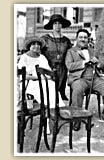|
From the nineteenth century onwards a bourgeois class was formed, closely linked to the state apparatus of power.
These were the old tzakia, professional politicians, lawyers and aristocrats from the
Seven Islands, General Staff officers, university professors, judges, officials
and the upper clergy.
|

Financiers, people whose income derived from state loans, could be included in this state middle class, as could the major landowners, in particular from Thessaly and Arta. The
traditional state bourgeois class, after the Trikoupist experiment,
showed signs of its limitations, a fact that had become evident
in the way its political representatives handled the ensuing crisis of the
1897 war.
The social structure of Greek society, however, was characterized by a particularly
wide petit bourgeois class, the traditional householders
of the city and the village: members included the liberal professions, manufacturers, petty merchants,
mediators between the agricultural production and small trade, low ranking civil servants,
small landowners and those occupied in petty services. These social classes are organically
related to state mechanism and in consequence to the state class through the system
of patron-client relationships. A feature of this society was its opportunities for social mobility,
boosted by an educational system both in the secondary
and higher education, accessible to all. The social features of the petit
bourgeois class created a conservative political attitude which determined
the stance of these classes during the 1920s.
From the 1890s but even more dramatically throughout
the twentieth century, a new commerical middle class emerged. Engaged in export trade,
shipowners, financiers with an international career as well as the first industrialists
emerged on the scene of the still poor Greek state. They came from the world
of the Hellenism of paroikies (mercantile communities) and this new middle class sought to establish its hegemony
over Greek society. The fact that they expressed claims to power gave shape to the social
basis of the political conflicts that took place in the country from 1909 onwards.
|
 |
